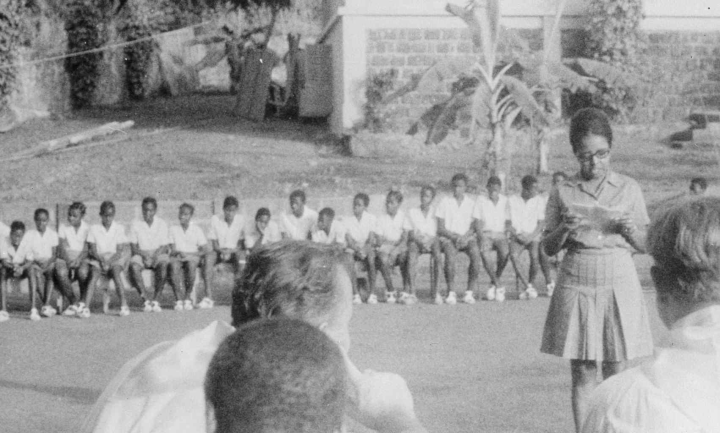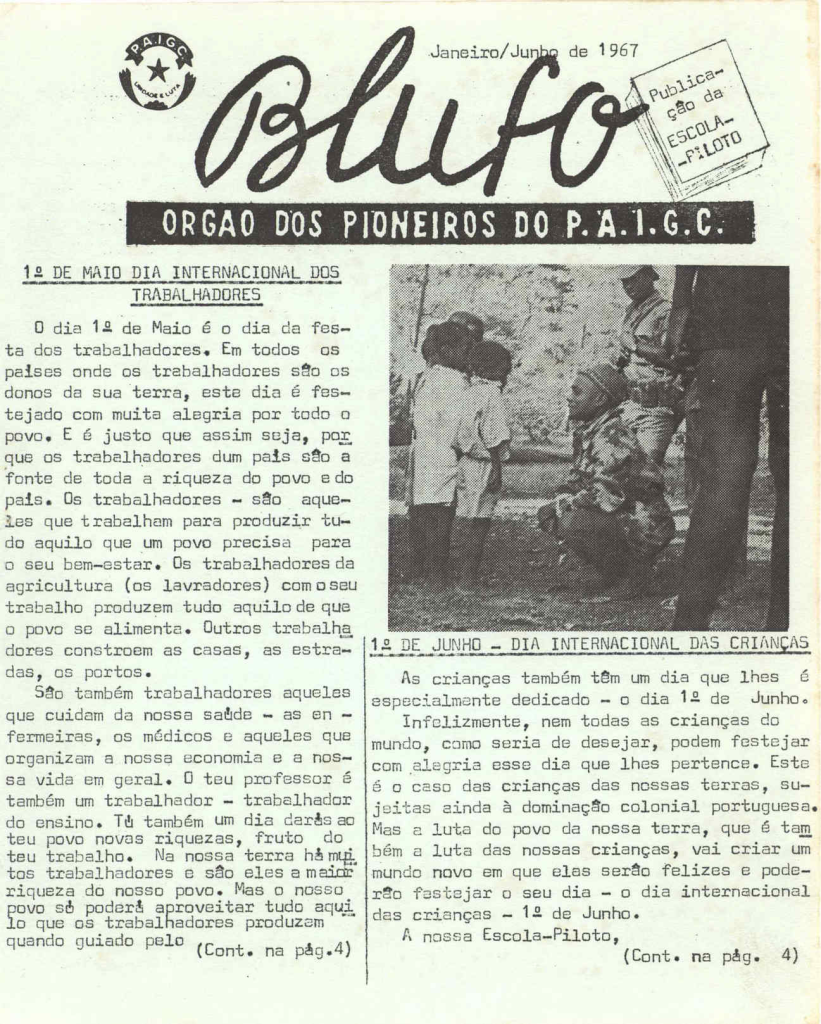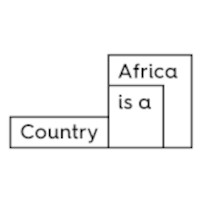Jill Rosemary Dias collection em Memórias de África e do Oriente CC0.
This post is part of the “Revolutionary Papers” series.
The 1959 Pidjiguiti Massacre served as an important historical marker in the curriculum of the anticolonial resistance in Guinea-Bissau.
BY Priscilla Marques Campos TRANSLATION BY Ali Sargent
On August 3, 1959, at the docks of Pidjiguiti, in the Port of Bissau, on the banks of the Geba River, there was a strike of seafarers and dockworkers of the Manjaca ethnic majority. Their grievances revolved around the poor working conditions and requests for wage increases, echoing a political and economic dissatisfaction with the Portuguese colonial administration at the time.
The merchants of Casa Gouveia, the colonial company responsible for shipping products across the Atlantic, responded to the workers’ negotiation proposals with indifference and negligence. The strike action that day was violently repressed by the police, the army, and armed Portuguese civilian groups; some members of the police opposed the attack, so there was also civilian reinforcement. About 50 people were killed and 100 were wounded. The repression was very violent, leaving widespread death and a legacy of pain and anguish among the local population.
Since then, the Pidjiguiti Massacre has been remembered as a turning point in the history of resistance to Portuguese colonial oppression. This memory was passed down to youth during the liberation struggle as an important part of militant education for liberation prioritized by the Partido Africano para a Independência da Guiné e Cabo Verde (African Party for the Independence of Guinea-Bissau and Cabo Verde, PAIGC) in its 11-year anti-colonial war.
From 1963-1974, the anticolonial struggle against the Portuguese was led by the PAIGC. Amílcar Cabral’s party considered the Pidjiquiti Massacre as a political trigger for the beginning of the guerrilla war, demonstrating the urgency of a process that would transform people’s lives in Guinea-Bissau and Cabo Verde. In the face of deep divisions, the PAIGC promoted an ideal of national unification, believing that colonial oppression was something that affected everyone. The party was seen as an embryo for the construction of a nation independent from colonialism.
The PAIGC militants understood the fundamental power that the education of children and adults fulfilled in the decolonization struggle, so one of the political developments for the areas liberated from colonialism by the PAIGC was the creation of schools. The process of educational development during the struggle in Guinea-Bissau was described by Brazilian educator Paulo Freire in the book Cartas à Guiné-Bissau (1977), where he refers to Amilcar Cabral as a “Pedagogo da Revolução” (Revolutionary Educator).
The first PAIGC congress was held in 1964, in the liberated area of Cassacá. The militants met to agree on their next steps politically, to fight against deviations, and evaluate their successes and failures in military terms. They also debated the social and political model for the liberated areas, considering how best to structure the tabancas (villages) in the countryside to avoid repeating the damages of the Portuguese administration. They aimed to initiate a project of socialized popular power, through the establishment of medical centers, a headquarters for the local administration, popular stores, and schools.
During the Cassacá conference, the Departments for Information, Culture and Personnel Training of the PAIGC Central Committee were created. These departments were responsible for education and publishing policies. From that Congress, under the leadership of Luis Cabral, the Escola Piloto (Pilot School) was created in neighboring Guinea, where there was also a PAIGC base. Two newspapers were established in this period: A Libertação (The Liberation), the organization’s official propaganda tool, and Blufo, intended for school children and young people in the liberated areas. Luís Cabral supervised the production of Blufo. Issues are available online at Casa Comum’s archive, where I studied 22 editions produced by the Escola Piloto in Guinea Conakry.

Picture of Escola Piloto of Conakry, with the Director Lilica Boal, during a visit of the soviet school delegation (1965). Image courtesy of the Mário Soares Foundation.
Historians have always looked to newspapers to understand better how historical processes unfolded around the world. Brazilian historians Heloisa Cruz and Maria Peixoto remind us that newspapers were not produced to become historical sources or research material; they are part of the heat of the present, vehicles of opinion. This makes them valuable material for the study of ideas and political projects.
The newspaper was an educational tool to reinforce the PAIGC’s narrative about the forms of struggle necessary for independence, part of the party’s approach to “militant education.” In PAIGC schools, the question of the political struggle for independence was never far removed from everyday life. All children attending these schools were connected to and participated in the ideals of building a new nation. Blufo was a political communication tool for the pioneers, keeping them up to date on the events of the revolution. Besides being part of the curriculum, it also provided a sense of identity and a source of training for political and intellectual cadres.
Blufo was made available free of charge in PAIGC schools and distributed between January 1966 and December 1970. It aimed to reach the party’s Pioneers, a student body formed by children of fighters, PAIGC militants, war orphans, and other young people. Some articles were signed by school members, teachers, and letters from students. Others were texts from outside the schools, such as from PAIGC militants and Amilcar Cabral, and some were unsigned, attributed to the newspaper’s editorial board. Unlike other guerrilla newspapers that preferred not to name their authors to preserve their clandestine identities, Blufo was published within liberated areas, so there was no such concern. Blufo was produced in Portuguese, using a typewriter, and printed in A4-size pages. The length of each publication varied: the initial editions were shorter at four pages, and editions 10, 11, and 12 more extensive, at 12 pages.

In the 11 editions of the newspaper available in the archive, four include references to the Pidjiquiti Massacre, as a way to build memory within the anti-colonial struggle. For example, there are newspaper tributes to the victims of this Portuguese attack on sailors and dockworkers on International Workers’ Day, (May 1, 1968), and on the day of strike action August 3, at the PAIGC School in Artek. Victims of the massacre are held as an inspiration to continue the struggle for independence, to remind readers that they should not accept their precarious working conditions and lack of labor rights. The analysis and reminder of the history of Pidjiguiti appears as motivation towards the radicalization of guerilla war against the tugas (Portuguese).
With the first editions of Blufo published eight years after the massacre, the newspaper educated young people who were not born at the time or who did not remember events, and so turned it into a significant date in national history. In Blufo the history of anticolonialism in Guinea-Bissau and Cabo Verde was discussed in simple and accessible language so that it could become everyday knowledge for the new generation. “Always keep in mind that people are not fighting for ideas, for things that are in anyone’s head. They are fighting for material benefits, to live better and in peace, to see their lives progress, to secure the future of their children.” This statement by Amilcar Cabral reveals that people were not participating in the struggle purely for an ideological cause, but because of the need for urgent improvements in their living conditions.
The strike that occurred on the day of the Pidjiguiti Massacre was motivated by the lack of payment of wages, which led to the question: How is it possible to survive under these conditions? How can we lead dignified lives? How can we support our families? In the same 1965 speech, “Tell no lies, claim no easy victories…” Cabral acknowledges the challenges faced by the PAIGC and reminds the party and the army that there were weaknesses to improve on and that often their actions were insufficient, emphasizing that they were armed political militants, and not simply soldiers. Before the guerrilla war began, the leaders of the nationalist struggle hoped that direct action—strikes and protests such as those in Pidjiguiti—would be enough to get the Portuguese to negotiate, but after the violent response they had no choice but to radicalize. The framing of the history of the massacre in the curriculum for youth in PAIGC pilot schools written in Blufo is a tribute to the work and role of radical education in building collective memory needed to motivate and sustain the liberation struggle.
About the Author
Priscilla Marques Campos is a Brazilian master of African social history. She is chief editor of Hydra Journal and enconto orí Review.
About the Translator
Ali Sargent is a translator, writer, and filmmaker from London.






